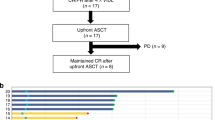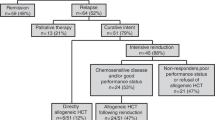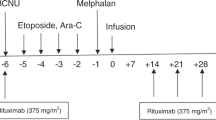Abstract
From January 2004 to December 2008, 50 consecutive patients with high-risk neuroblastoma were assigned to receive tandem HDCT (high-dose chemotherapy)/auto-SCT after nine cycles of induction chemotherapy. CEC (carboplatin+etoposide+cyclophosphamide) regimen and TM (thiotepa+melphalan)-TBI regimen (or TM regimen for stage 3 patients) were the first and second HDCT regimens. Local radiotherapy, differentiation therapy with 13-cis-retinoid acid and immunotherapy with interleukin-2 were given after tandem HDCT/auto-SCT. Of the 50 patients, 49 underwent a first HDCT/auto-SCT and 47 underwent a second HDCT/auto-SCT. The tumor relapsed or progressed in 14 patients, secondary malignancy developed in one patient and one patient died from chronic lung disease. Therefore, 34 patients remained event free with a median follow-up of 54.5 months (range, 14–94 months) from diagnosis. The probabilities of 5-year OS and EFS for all 50 patients were 77.0% (95% confidence interval (CI), 63.7–90.3) and 71.4% (95% CI, 58.7–84.1), respectively. However, all patients who remained event free for >3 years after tandem HDCT/auto-SCT experienced late adverse effects. Chemotherapeutic dose-escalation strategy using tandem HDCT/auto-SCT was very encouraging for survival. However, further studies incorporating newer treatment modalities are needed to reduce late adverse effects without jeopardizing the survival rate.
This is a preview of subscription content, access via your institution
Access options
Subscribe to this journal
Receive 12 print issues and online access
$259.00 per year
only $21.58 per issue
Buy this article
- Purchase on Springer Link
- Instant access to full article PDF
Prices may be subject to local taxes which are calculated during checkout

Similar content being viewed by others
References
Philip T, Ladenstein R, Lasset C, Hartmann O, Zucker JM, Pinkerton R et al. 1070 myeloablative megatherapy procedures followed by stem cell rescue for neuroblastoma: 17 years of European experience and conclusions. European Group for Blood and Marrow Transplant Registry Solid Tumour Working Party. Eur J Cancer 1997; 33: 2130–2135.
Matthay KK, Villablanca JG, Seeger RC, Stram DO, Harris RE, Ramsay NK et al. Treatment of high-risk neuroblastoma with intensive chemotherapy, radiotherapy, autologous bone marrow transplantation, and 13-cis-retinoic acid. Children's Cancer Group. N Engl J Med 1999; 341: 1165–1173.
Berthold F, Boos J, Burdach S, Erttmann R, Henze G, Hermann J et al. Myeloablative megatherapy with autologous stem-cell rescue versus oral maintenance chemotherapy as consolidation treatment in patients with high-risk neuroblastoma: a randomized controlled trial. Lancet Oncol 2005; 6: 649–658.
Pritchard J, Cotterill SJ, Germond SM, Imeson J, de Kraker J, Jones DR . High dose melphalan in the treatment of advanced neuroblastoma: results of a randomised trial (ENSG-1) by the European Neuroblastoma Study Group. Pediatr Blood Cancer 2005; 44: 348–357.
George RE, Li S, Medeiros-Nancarrow C, Neuberg D, Marcus K, Shamberger RC et al. High-risk neuroblastoma treated with tandem autologous peripheral-blood stem cell-supported transplantation: long-term survival update. J Clin Oncol 2006; 24: 2891–2896.
Kletzel M, Katzenstein HM, Haut PR, Yu AL, Morgan E, Reynolds M et al. Treatment of high-risk neuroblastoma with triple-tandem high-dose therapy and stem-cell rescue: results of the Chicago Pilot II Study. J Clin Oncol 2002; 20: 2284–2292.
Sung KW, Lee SH, Yoo KH, Jung HL, Cho EJ, Koo HH et al. Tandem high-dose chemotherapy and autologous stem cell rescue in patients over 1 year of age with stage 4 neuroblastoma. Bone Marrow Transplant 2007; 40: 37–45.
Brodeur GM, Pritchard J, Berthold F, Carlsen NL, Castel V, Castelberry RP et al. Revisions of the international criteria for neuroblastoma diagnosis, staging, and response to treatment. J Clin Oncol 1993; 11: 1466–1477.
Shimada H, Ambros IM, Dehner LP, Hata J, Joshi VV, Roald B et al. The International Neuroblastoma Pathology Classification (the Shimada system). Cancer 1999; 86: 364–372.
Corbett R, Pinkerton R, Tait D, Meller S . [131I]metaiodobenzylguanidine and high-dose chemotherapy with bone marrow rescue in advanced neuroblastoma. J Nucl Biol Med 1991; 35: 228–231.
Gaze MN, Wheldon TE, O′Donoghue JA, Hilditch TE, McNee SG, Simpson E et al. Multi-modality megatherapy with [131I]meta-iodobenzylguanidine, high dose melphalan and total body irradiation with bone marrow rescue: feasibility study of a new strategy for advanced neuroblastoma. Eur J Cancer 1995; 31A: 252–256.
Klingebiel T, Bader P, Bares R, Beck J, Hero B, Jürgens H et al. Treatment of neuroblastoma stage 4 with 131I-meta-iodo-benzylguanidine, high-dose chemotherapy and immunotherapy. A pilot study. Eur J Cancer 1998; 34: 1398–1402.
Yanik GA, Levine JE, Matthay KK, Sisson JC, Shulkin BL, Shapiro B et al. Pilot study of iodine-131-metaiodobenzylguanidine in combination with myeloablative chemotherapy and autologous stem-cell support for the treatment of neuroblastoma. J Clin Oncol 2002; 20: 2142–2149.
Miano M, Garaventa A, Pizzitola MR, Piccolo MS, Dallorso S, Villavecchia GP et al. Megatherapy combining I(131) metaiodobenzylguanidine and high-dose chemotherapy with haematopoietic progenitor cell rescue for neuroblastoma. Bone Marrow Transplant 2001; 27: 571–574.
Matthay KK, Tan JC, Villablanca JG, Yanik GA, Veatch J, Franc B et al. Phase I dose escalation of iodine-131-metaiodobenzylguanidine with myeloablative chemotherapy and autologous stem-cell transplantation in refractory neuroblastoma: a new approaches to Neuroblastoma Therapy Consortium Study. J Clin Oncol 2006; 24: 500–506.
Cheung NK, Kushner BH, Kramer K . Monoclonal antibody-based therapy of neuroblastoma. Hematol Oncol Clin North Am 2001; 15: 853–866.
Osenga KL, Hank JA, Albertini MR, Gan J, Sternberg AG, Eickhoff J et al. A phase I clinical trial of the hu14.18-IL2 (EMD 273063) as a treatment for children with refractory or recurrent neuroblastoma and melanoma: a study of the Children′s Oncology Group. Clin Cancer Res 2006; 12: 1750–1759.
Kushner BH, Kramer K, Cheung NK . Phase II trial of the anti-G(D2) monoclonal antibody 3F8 and granulocyte-macrophage colony-stimulating factor for neuroblastoma. J Clin Oncol 2001; 19: 4189–4194.
Simon T, Hero B, Faldum A, Handgretinger R, Schrappe M, Niethammer D et al. Consolidation treatment with chimeric anti-GD2-antibody ch14.18 in children older than 1 year with metastatic neuroblastoma. J Clin Oncol 2004; 22: 3549–3557.
Yu AL, Gilman AL, Ozkaynak MF, London WB, Kreissman SG, Chen HX et al. Anti-GD2 antibody with GM-CSF, interleukin-2, and isotretinoin for neuroblastoma. N Engl J Med 2010; 363: 1324–1334.
Flandin I, Hartmann O, Michon J, Pinkerton R, Coze C, Stephan JL et al. Impact of TBI on late effects in children treated by megatherapy for Stage IV neuroblastoma. A study of the French Society of Pediatric oncology. Int J Radiat Oncol Biol Phys 2006; 64: 1424–1431.
Hobbie WL, Moshang T, Carlson CA, Goldmuntz E, Sacks N, Goldfarb SB et al. Late effects in survivors of tandem peripheral blood stem cell transplant for high-risk neuroblastoma. Pediatr Blood Cancer 2008; 51: 679–683.
Acknowledgements
We thank Miss So Yeon Lee for her assistance with data collection.
Author information
Authors and Affiliations
Corresponding author
Ethics declarations
Competing interests
The authors declare no conflict of interest.
Rights and permissions
About this article
Cite this article
Sung, K., Son, M., Lee, S. et al. Tandem high-dose chemotherapy and autologous stem cell transplantation in patients with high-risk neuroblastoma: Results of SMC NB-2004 study. Bone Marrow Transplant 48, 68–73 (2013). https://doi.org/10.1038/bmt.2012.86
Received:
Revised:
Accepted:
Published:
Issue Date:
DOI: https://doi.org/10.1038/bmt.2012.86
Keywords
This article is cited by
-
Efficacy of intrathecal methotrexate in children with high-risk medulloblastoma over three years: a retrospective study from a single center
Journal of Neuro-Oncology (2023)
-
Pharmacokinetics of high-dose carboplatin in children undergoing high-dose chemotherapy and autologous stem cell transplantation with BSA-based dosing
Bone Marrow Transplantation (2020)
-
Incorporation of high-dose 131I-metaiodobenzylguanidine treatment into tandem high-dose chemotherapy and autologous stem cell transplantation for high-risk neuroblastoma: results of the SMC NB-2009 study
Journal of Hematology & Oncology (2017)
-
Toxicity of tandem high-dose chemotherapy and autologous stem cell transplantation using carboplatin-thiotepa-etoposide and cyclophosphamide-melphalan regimens for malignant brain tumors in children and young adults
Journal of Neuro-Oncology (2014)



